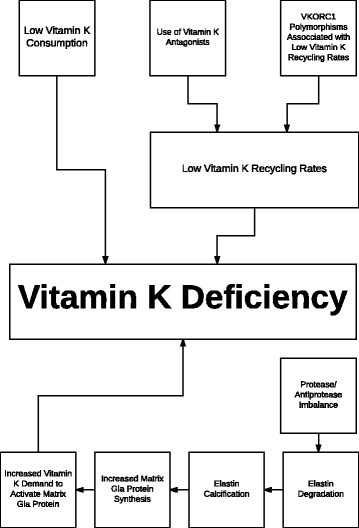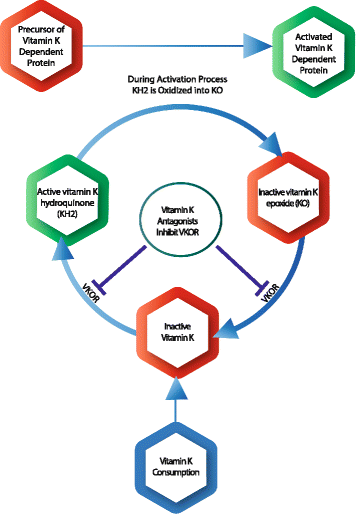Vitamin K deficiency: the linking pin between COPD and cardiovascular diseases?
- PMID: 29132356
- PMCID: PMC5683584
- DOI: 10.1186/s12931-017-0673-z
Vitamin K deficiency: the linking pin between COPD and cardiovascular diseases?
Abstract
Cardiovascular diseases are prevalent in patients with chronic obstructive pulmonary disease (COPD). Their coexistence implies that many COPD patients require anticoagulation therapy. Although more and more replaced by direct oral anticoagulants, vitamin K antagonists (VKAs) are still widely used. VKAs induce profound deficiency of vitamin K, a key activator in the coagulation pathway. It is recognized however that vitamin K is also an essential cofactor in the activation of other extrahepatic proteins, such as matrix Gla protein (MGP), a potent inhibitor of arterial calcification. No or insufficient MGP activation by the use of VKAs is associated with a rapid progression of vascular calcification, which may enhance the risk for overt cardiovascular disease. Vitamin K consumption, on the other hand, seems to have a protective effect on the mineralization of arteries. Furthermore, vascular calcification mutually relates to elastin degradation, which is accelerated in patients with COPD associating with impaired survival. In this commentary, we hypothesize that vitamin K is a critical determinant to the rate of elastin degradation. We speculate on the potential link between poor vitamin K status and crucial mechanisms of COPD pathogenesis and raise concerns about the use of VKAs in patients with this disease. Future intervention studies are needed to explore if vitamin K supplementation is able to reduce elastin degradation and vascular calcification in COPD patients.
Keywords: COPD; Cardiovascular diseases; Desmosine; Elastin; Matrix Gla protein; Vascular calcification; Vitamin K; Vitamin K antagonists.
Conflict of interest statement
Ethics approval and consent to participate
Not applicable.
Consent for publication
Not applicable.
Competing interests
CV is an employee of R&D Group VitaK. WJ is a senior clinical investigator of the Flemish Research Funds (FWO). None declared (IP, EFMW, FMEF and RJ).
Publisher’s Note
Springer Nature remains neutral with regard to jurisdictional claims in published maps and institutional affiliations.
Figures



References
-
- Vogelmeier CF, Criner GJ, Martinez FJ, Anzueto A, Barnes PJ, Bourbeau J, Celli BR, Chen R, Decramer M, Fabbri LM, et al. Global strategy for the diagnosis, management, and prevention of chronic obstructive lung disease 2017 report: GOLD executive summary. Am J Respir Crit Care Med. 2017;195:557–582. doi: 10.1164/rccm.201701-0218PP. - DOI - PubMed
-
- Williams MC, Murchison JT, Edwards LD, Agustí A, Bakke P, Calverley PM, Celli B, Coxson HO, Crim C, Lomas DA, et al. Coronary artery calcification is increased in patients with COPD and associated with increased morbidity and mortality. Thorax. 2014;69:718–723. doi: 10.1136/thoraxjnl-2012-203151. - DOI - PubMed
-
- Terzano C, Romani S, Conti V, Paone G, Oriolo F, Vitarelli A. Atrial fibrillation in the acute, hypercapnic exacerbations of COPD. Eur Rev Med Pharmacol Sci. 2014;18:2908–2917. - PubMed
Publication types
MeSH terms
Substances
LinkOut - more resources
Full Text Sources
Other Literature Sources
Medical
Miscellaneous

